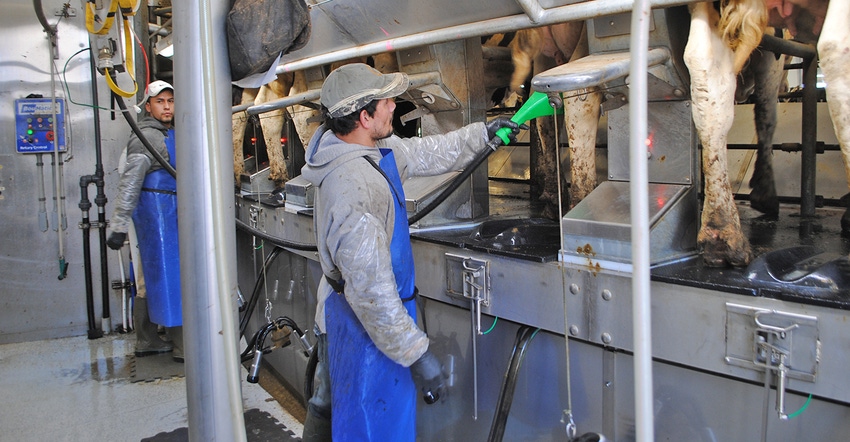October 23, 2017

By Sandy Stuttgen
The goal of the milking protocol is to attach the milking unit to sanitized teats at the peak of the cow’s letdown. You investing two minutes of time prior to unit attachment is rewarded by low microbial contamination in bulk-tank milk, healthy teat ends, and fast and complete milk-outs. To earn these rewards, the two-minute interval must include 30 seconds of antiseptic contact and at least 90 seconds of lag time.
Contact time
Antiseptics are chemicals applied to living tissue to kill microorganisms present on that tissue. Formulated as impregnated wipes, sprays, dips and foams, premilking antiseptics are applied to teat skin to minimize the number of viable microorganisms transferred from teat skin to the bulk tank. Teats must be free of visible dirt or manure before applying antiseptics. Antiseptics are expensive wetting agents when applied to mud or manure; untreated skin with living microorganisms remain after the applied antiseptic is wiped from dirty teats.
Microbial killing is a function of the antiseptic’s chemical action and time. No products marketed today have an instantaneous kill. Time is needed to breakdown the microbe’s biological defenses. It takes at least 30 seconds of contact on clean skin to achieve adequate antisepsis.
Lag time
Milk letdown is a biological process triggered by stimulating the teat. With a positive milking experience, the sights and sounds of the milking process will begin to trigger letdown. Cows may be dripping milk as they enter the parlor, but that is cisternal milk, not the milk present in the mammary tissue. Touch is necessary to signal the pituitary gland to secrete the oxytocin needed to squeeze milk from mammary alveoli.
Between milkings, milk produced in the udder is stored in microscopic sacs known as alveoli. Smooth muscle cells surround each alveolus. As these muscles contract in response to oxytocin, alveoli milk is squeezed into milk ducts, which drain into the gland cistern. Milk from the gland cistern drains into the teat cistern and exits the teat through the teat canal.
Nerves present in teat skin sense physical manipulation, and the impulse is carried by the nervous system to the brain. The pituitary gland within the brain receives the signal and in response, secretes oxytocin in the bloodstream. It takes at least 90 seconds for the impulse triggered at the teat end to reach the pituitary gland and the secreted oxytocin to be carried via the bloodstream to the alveoli. This biological interval is known as lag time.
The start of lag time occurs with strong physical manipulation of the teat, which is best achieved by fore-stripping, washing, wiping or drying. Foaming, dipping or spraying teats with antiseptic does not provide enough stimulus to begin the letdown sequence. Whichever steps you choose to incorporate into your milking routine, make sure to allow at least 90 seconds after the teat was adequately handled for lag time to occur.
Lag time ends as the alveoli are squeezed in response to oxytocin; the teats swell with milk. Units attached to teats that are plump with milk capture the peak oxytocin effect, and cows will quickly milk out.
Don’t use the milking machine as the stimulation to start the lag time; it’s physically too strong, and teat ends will be damaged when the unit is applied before the teats are plump with milk. Milk flowing from the teat canal bathes the teat and helps protect the vulnerable teat ends from the damaging effects of vacuum and pulsation.
Two minutes feels like a long time in our world of high-speed internet and instant messaging; however, the two biological processes of killing microbes and oxytocin release cannot be rushed. Use a stopwatch to remind yourself and your workers how long antiseptic contact time (30 seconds) and lag time (90 seconds) needs to be.
Stuttgen is the Extension agriculture educator in Taylor County, Wis. This column is provided by the University of Wisconsin Extension Dairy Team.
You May Also Like




